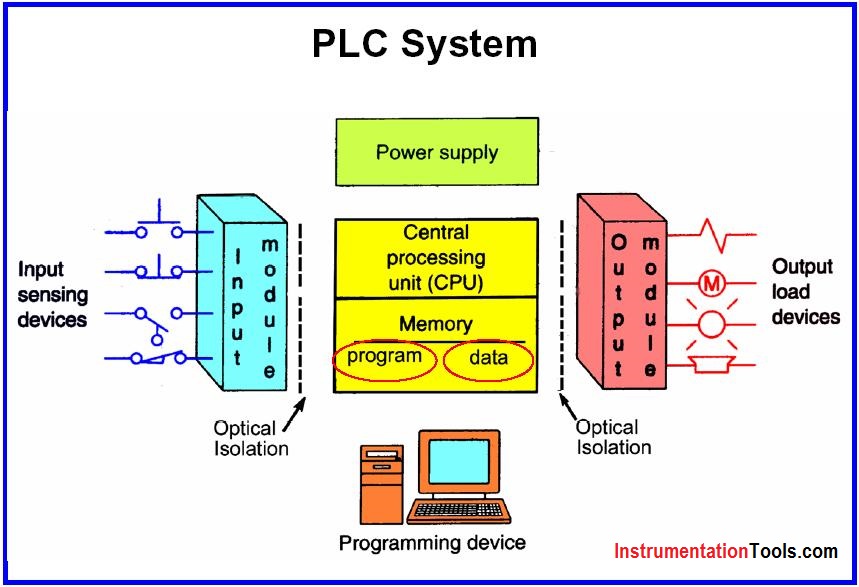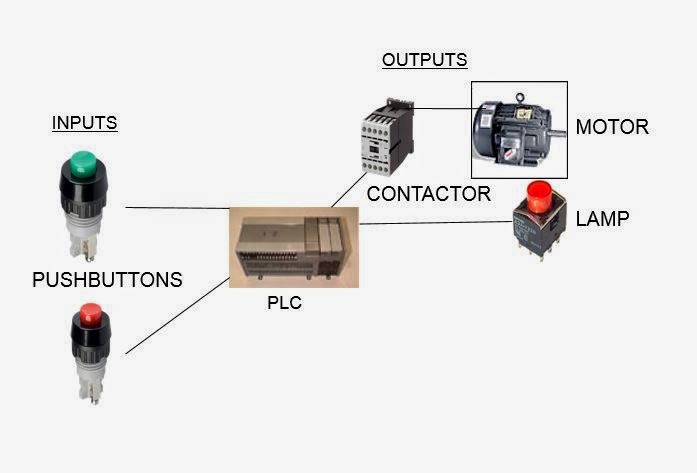Architecture of PLC
PLC system contains of the following parts
- Power supply
- CPU
- Input modules
- Output modules
- Programming Device
Power Supply :
This module supplies power to the CPU, input and output modules. It can be built into the PLC or be an external unit. Common voltage levels required by the PLC (with and without the power supply) are
24Vdc, 110Vac, 220Vac.
CPU (Central Processing Unit):
This module is considered as the brain of the PLC system and where
ladder logic is stored and processed.
•The memory contains the data and the ladder program.
It contains an “Executive” program that tells the PLC how to:
• Execute the control Instructions
• User’s Program
• Communicate with other devices
• Other PLCs, Programming devices, I/O devices, etc.
• Perform Housekeeping activities
• Diagnostics, etc
This program is stored in “nonvolatile” memory
• Meaning that the program will not be lost if power is removed.
I/O MODULES:
-
Ø The I/O interface section of a PLC connects it to external field devices.
-
Ø The main purpose of the I/O interface is to condition the various signals received from or sent to the external input and output devices
-
Ø Inputs to, and outputs from, a PLC are necessary to monitor and control a process. Both inputs and outputs can be categorized into two basic types: logical or continuous.
Consider the example of a light bulb:
- If it can only be turned on or off, it is logical control.
- If the light can be dimmed to different levels, it is continuous. Continuous values seem more intuitive, but logical values are preferred because they allow more certainty, and simplify control. As a result most controls applications (and PLCs) use logical inputs and outputs for most applications.
Input module:
The input module connects the input terminals to the rest of the system. Each terminal is usually electrically isolated from the internal electronics by OPTO ISOLATORS. This is a way of passing on the status of the input (on or off) by use of a light emitting diode and phototransistor. A typical opto isolator is shown. They have the advantage of reducing the effects of spurious pulses generated from electromagnetic sources. It is also a safety feature to prevent live voltages appearing on the input lines in the event of a fault.
Internally a computer usually operates at 5 V DC. The external devices (solenoids, motor starters, limit switches, etc.) operate at voltages up to 110 V AC. The mixing of these two voltages will cause severe and possibly irreparable damage to the PLC electronics. Less obvious problems can occur from electrical noise introduced into the PLC from voltage spikes on signal lines, or from load currents flowing in AC neutral or DC return lines. Differences in earth potential between the PLC cubicle and outside plant can also cause problems.
The question of noise is discussed, but there are obviously very good reasons for separating the plant supplies from the PLC supplies with some form of electrical barrier. This ensures that the PLC cannot be adversely affected by anything happening on the plant. Even a cable fault putting 415 V AC onto a DC input would only damage the input card; the PLC itself (and the other cards in the system) would not suffer. This is achieved by optical isolators, a light-emitting diode and photo-electric transistor linked together.
Protection of the PLC from outside faults. The PLC supply L1/N1 is separate from the plant supply L2/N2 switch on. Because there are no electrical connections between the diode and the transistor, very good electrical isolation (typically 1 and 4kV) is achieved.
A DC input can be provided. When the push-button is pressed, current will flow through D1, causing TR1 to turn on, passing the signal to the PLC internal logic. Diode D2 is a light-emitting diode used as a fault-finding aid to show when the input signal is present. Such indicators are present on almost all PLC input and output cards.
The resistor R sets the voltage range of the input. DC input cards are usually available for three voltage ranges: 5V (TTL), 12V 24V, 24V 50V.
A possible AC input circuit. The bridge rectifier is used to convert the AC to full wave rectified DC. Resistor R2 and capacitor C1 act as a filter (of about 50ms time constant) to give a clean signal to the PLC logic. As before, a neon LP1 acts as an input signal indicator for fault finding, and resistor R1 sets the voltage range. The isolation barrier and monitoring LEDs can be clearly seen. This card handles eight inputs and could be connected to the outside world.
Following are the some of the Input devices.
• FIeld Transmitters for Pressure, Temperature, Flow, Level etc
• Analyzers (pH, DO, Conductivity, SOX, NOX, etc)
• Switches and Push buttons
• Sensing Devices
• Limit Switches
• Photoelectric Sensors
• Proximity Sensors
• Condition Sensors
• Pressure Switches
• Level Switches
• Temperature Switches
• Vacuum Switches
• Float Switches
• Encoders
Inputs and Outputs connected to PLC
Outputs Modules:
Outputs to actuators allow a PLC to cause something to happen in a process. A short list of popular actuators is given below in order of relative popularity.
Solenoid Valves - Logical outputs that can switch a hydraulic or pneumatic flow.
Lights - Logical outputs that can often be powered directly from PLC output boards.
Motor Starters - Motors often draw a large amount of current when started, so they require motor starters, which are basically large relays.
Servo Motors - A continuous output from the PLC can command a variable speed
or position.
Outputs from PLCs are often relays, but they can also be solid state electronics such as transistors for DC outputs or Triacs for AC outputs. Continuous outputs require special output cards with digital to analog converters.
Output cards again require some form of isolation barrier to limit damage from the inevitable plant faults and also to stop electrical noise corrupting the processor’s operations. Interference can be more of a problem on outputs because higher currents are being controlled by Computers and industrial
There are two basic types of output card. Eight outputs are fed from a common supply, which originates local to the PLC cubicle (but separate from the supply to the PLC itself). This arrangement is the simplest and the cheapest to install.
Each output has its own individual fuse protection on the card and a common circuit breaker. It is important to design the system so that a fault, say, on load 3 blows the fuse FS3 but does not trip the supply to the whole card, shutting down every output. This topic, called discrimination, is discussed further in Chapter 8. A PLC frequently has to drive outputs which have their own individual supplies.
A typical example is a motor control centre (MCC) where each starter has a separate internal 110-V supply derived from the 415-V bars. The card arrangement could not be used here without separate interposing relays (driven by the PLC with contacts into the MCC circuit). An isolated output card, has individual out-puts and protection and acts purely as a switch.
This can be connected directly with any outside circuit. The disadvantage is that the card is more complicated (two connections per output) and safety becomes more involved. An eight-way isolated output card, for example, could have voltage on its terminals from eight different locations.
Relay outputs can be used (and do give the required isolation) but are not particularly common. A relay is an electromagnetic device with moving parts and hence a finite limited life. A purely electronic device will have greater reliability.
Less obviously, though, a relay-driven inductive load can generate troublesome interference and lead to early contact failure. Optical isolation is again used to give the necessary separation between the plant and the PLC system.
Diode D1 acts as a spike suppression diode to reduce the voltage spike encountered with inductive loads. The output state can be observed on LED1. If NPN transistors are used, a current sinking card can be made. AC output cards invariably use triacs, a typical circuit being.
Triacs have the advantage that they turn off at zero current in the load, which eliminates the interference as an inductive load is turned off. If possible, all AC loads should be driven from triacs rather than relays
An output card will have a limit to the current it can supply, usually set by the printed circuit board tracks rather than the output devices. An individual output current will be set for each output and a total overall output. Usually the total allowed for the card current is lower than the sum of the allowed individual outputs.
Free PLC Training Courses

